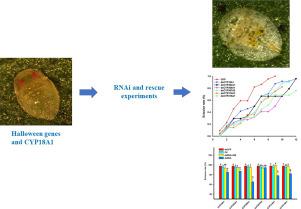当前位置:
X-MOL 学术
›
Pestic. Biochem. Phys.
›
论文详情
Our official English website, www.x-mol.net, welcomes your
feedback! (Note: you will need to create a separate account there.)
Molecular characterization and functional analysis of the Halloween genes and CYP18A1 in Bemisia tabaci MED
Pesticide Biochemistry and Physiology ( IF 4.2 ) Pub Date : 2020-07-01 , DOI: 10.1016/j.pestbp.2020.104602 Shaonan Liu 1 , Chao He 2 , Jinjin Liang 3 , Qi Su 1 , Dengke Hua 1 , Shaoli Wang 2 , Qingjun Wu 2 , Wen Xie 2 , Youjun Zhang 2
Pesticide Biochemistry and Physiology ( IF 4.2 ) Pub Date : 2020-07-01 , DOI: 10.1016/j.pestbp.2020.104602 Shaonan Liu 1 , Chao He 2 , Jinjin Liang 3 , Qi Su 1 , Dengke Hua 1 , Shaoli Wang 2 , Qingjun Wu 2 , Wen Xie 2 , Youjun Zhang 2
Affiliation

|
The ecdysteroid hormone 20-hydroxyecdysone (20E), a critical hormone in arthropods, plays an essential role in insect growth, molting and reproduction. A previous study showed that 20E is actually regulated by six P450 genes (five P450 genes belonging to the Halloween family and a CYP18A1 gene) in model insects. However, the role of the six P450 genes in Bemisia tabaci Q (also call Mediterranean, MED), an important pest of field crops, remains unclear. Here, six P450 genes were cloned by RT-PCR, and the phylogenetic tree indicated a close orthologous relationship of these P450 genes between MED and other insects. Spatiotemporal expression profiling revealed that five P450 genes (CYP18A1, CYP306A1, CYP307A2, CYP314A1 and CYP315A1) were expressed at significantly higher levels in the head than in the abdomen and thorax. Four P450 genes (CYP302A1, CYP307A2, CYP314A1 and CYP315A1) were expressed at the highest levels in males, and CYP18A1 was expressed at the highest levels in the 4th nymph stage. The molting process was delayed by approximately 1-3 days after knockdown of these genes at the 4th nymph stage, and the mean proportion of shriveled or dead insects reached 8.3% (CYP18A1), 20.8% (CYP302A1), 7.0% (CYP307A2), 31.8% (CYP306A1), 28.6% (CYP314A1) and 24.1% (CYP315A1). In addition, 20E rescued the negative effect of ds-CYP306A1, ds-CYP314A1 and ds-CYP315A1 on the eclosion rate. We concluded that these Halloween genes and CYP18A1 likely participate in the development of MED, and in particular, CYP306A1 could be used as a putative insecticide target for controlling this piercing-sucking insect.
中文翻译:

烟粉虱MED中万圣节基因和CYP18A1的分子特征和功能分析
蜕皮激素 20-羟基蜕皮激素 (20E) 是节肢动物中的一种关键激素,在昆虫生长、蜕皮和繁殖中起着至关重要的作用。之前的一项研究表明,20E 实际上是由模型昆虫中的六个 P450 基因(五个属于万圣节家族的 P450 基因和一个 CYP18A1 基因)调节的。然而,六个 P450 基因在烟粉虱 Q(也称为地中海,MED)中的作用尚不清楚,这是一种重要的大田作物害虫。在这里,通过 RT-PCR 克隆了六个 P450 基因,系统发育树表明这些 P450 基因在 MED 与其他昆虫之间存在密切的直系同源关系。时空表达谱显示五个 P450 基因(CYP18A1、CYP306A1、CYP307A2、CYP314A1 和 CYP315A1)在头部的表达水平明显高于腹部和胸部。四个 P450 基因(CYP302A1、CYP307A2、CYP314A1和CYP315A1)在雄性中表达量最高,CYP18A1在若虫4期表达量最高。在第4若虫期敲除这些基因后,蜕皮过程延迟约1-3天,枯萎或死亡昆虫的平均比例达到8.3%(CYP18A1),20.8%(CYP302A1),7.0%(CYP307A2), 31.8% (CYP306A1)、28.6% (CYP314A1) 和 24.1% (CYP315A1)。此外,20E挽救了ds-CYP306A1、ds-CYP314A1和ds-CYP315A1对羽化率的负面影响。我们得出结论,这些万圣节基因和 CYP18A1 可能参与了 MED 的发展,特别是 CYP306A1 可以用作控制这种刺吸昆虫的推定杀虫剂靶点。CYP18A1在若虫第4期表达量最高。在第4若虫期敲除这些基因后,蜕皮过程延迟约1-3天,枯萎或死亡昆虫的平均比例达到8.3%(CYP18A1),20.8%(CYP302A1),7.0%(CYP307A2), 31.8% (CYP306A1)、28.6% (CYP314A1) 和 24.1% (CYP315A1)。此外,20E挽救了ds-CYP306A1、ds-CYP314A1和ds-CYP315A1对羽化率的负面影响。我们得出结论,这些万圣节基因和 CYP18A1 可能参与了 MED 的发展,特别是 CYP306A1 可以用作控制这种刺吸昆虫的推定杀虫剂靶点。CYP18A1在若虫第4期表达量最高。在第4若虫期敲除这些基因后,蜕皮过程延迟约1-3天,枯萎或死亡昆虫的平均比例达到8.3%(CYP18A1),20.8%(CYP302A1),7.0%(CYP307A2), 31.8% (CYP306A1)、28.6% (CYP314A1) 和 24.1% (CYP315A1)。此外,20E挽救了ds-CYP306A1、ds-CYP314A1和ds-CYP315A1对羽化率的负面影响。我们得出结论,这些万圣节基因和 CYP18A1 可能参与了 MED 的发展,特别是 CYP306A1 可以用作控制这种刺吸昆虫的推定杀虫剂靶点。枯萎或死亡昆虫的平均比例分别达到8.3%(CYP18A1)、20.8%(CYP302A1)、7.0%(CYP307A2)、31.8%(CYP306A1)、28.6%(CYP314A1)和24.1%(CYP31A1)。此外,20E挽救了ds-CYP306A1、ds-CYP314A1和ds-CYP315A1对羽化率的负面影响。我们得出结论,这些万圣节基因和 CYP18A1 可能参与了 MED 的发展,特别是 CYP306A1 可以用作控制这种刺吸昆虫的推定杀虫剂靶点。枯萎或死亡昆虫的平均比例分别达到8.3%(CYP18A1)、20.8%(CYP302A1)、7.0%(CYP307A2)、31.8%(CYP306A1)、28.6%(CYP314A1)和24.1%(CYP31A1)。此外,20E挽救了ds-CYP306A1、ds-CYP314A1和ds-CYP315A1对羽化率的负面影响。我们得出结论,这些万圣节基因和 CYP18A1 可能参与了 MED 的发展,特别是 CYP306A1 可以用作控制这种刺吸昆虫的推定杀虫剂靶点。
更新日期:2020-07-01
中文翻译:

烟粉虱MED中万圣节基因和CYP18A1的分子特征和功能分析
蜕皮激素 20-羟基蜕皮激素 (20E) 是节肢动物中的一种关键激素,在昆虫生长、蜕皮和繁殖中起着至关重要的作用。之前的一项研究表明,20E 实际上是由模型昆虫中的六个 P450 基因(五个属于万圣节家族的 P450 基因和一个 CYP18A1 基因)调节的。然而,六个 P450 基因在烟粉虱 Q(也称为地中海,MED)中的作用尚不清楚,这是一种重要的大田作物害虫。在这里,通过 RT-PCR 克隆了六个 P450 基因,系统发育树表明这些 P450 基因在 MED 与其他昆虫之间存在密切的直系同源关系。时空表达谱显示五个 P450 基因(CYP18A1、CYP306A1、CYP307A2、CYP314A1 和 CYP315A1)在头部的表达水平明显高于腹部和胸部。四个 P450 基因(CYP302A1、CYP307A2、CYP314A1和CYP315A1)在雄性中表达量最高,CYP18A1在若虫4期表达量最高。在第4若虫期敲除这些基因后,蜕皮过程延迟约1-3天,枯萎或死亡昆虫的平均比例达到8.3%(CYP18A1),20.8%(CYP302A1),7.0%(CYP307A2), 31.8% (CYP306A1)、28.6% (CYP314A1) 和 24.1% (CYP315A1)。此外,20E挽救了ds-CYP306A1、ds-CYP314A1和ds-CYP315A1对羽化率的负面影响。我们得出结论,这些万圣节基因和 CYP18A1 可能参与了 MED 的发展,特别是 CYP306A1 可以用作控制这种刺吸昆虫的推定杀虫剂靶点。CYP18A1在若虫第4期表达量最高。在第4若虫期敲除这些基因后,蜕皮过程延迟约1-3天,枯萎或死亡昆虫的平均比例达到8.3%(CYP18A1),20.8%(CYP302A1),7.0%(CYP307A2), 31.8% (CYP306A1)、28.6% (CYP314A1) 和 24.1% (CYP315A1)。此外,20E挽救了ds-CYP306A1、ds-CYP314A1和ds-CYP315A1对羽化率的负面影响。我们得出结论,这些万圣节基因和 CYP18A1 可能参与了 MED 的发展,特别是 CYP306A1 可以用作控制这种刺吸昆虫的推定杀虫剂靶点。CYP18A1在若虫第4期表达量最高。在第4若虫期敲除这些基因后,蜕皮过程延迟约1-3天,枯萎或死亡昆虫的平均比例达到8.3%(CYP18A1),20.8%(CYP302A1),7.0%(CYP307A2), 31.8% (CYP306A1)、28.6% (CYP314A1) 和 24.1% (CYP315A1)。此外,20E挽救了ds-CYP306A1、ds-CYP314A1和ds-CYP315A1对羽化率的负面影响。我们得出结论,这些万圣节基因和 CYP18A1 可能参与了 MED 的发展,特别是 CYP306A1 可以用作控制这种刺吸昆虫的推定杀虫剂靶点。枯萎或死亡昆虫的平均比例分别达到8.3%(CYP18A1)、20.8%(CYP302A1)、7.0%(CYP307A2)、31.8%(CYP306A1)、28.6%(CYP314A1)和24.1%(CYP31A1)。此外,20E挽救了ds-CYP306A1、ds-CYP314A1和ds-CYP315A1对羽化率的负面影响。我们得出结论,这些万圣节基因和 CYP18A1 可能参与了 MED 的发展,特别是 CYP306A1 可以用作控制这种刺吸昆虫的推定杀虫剂靶点。枯萎或死亡昆虫的平均比例分别达到8.3%(CYP18A1)、20.8%(CYP302A1)、7.0%(CYP307A2)、31.8%(CYP306A1)、28.6%(CYP314A1)和24.1%(CYP31A1)。此外,20E挽救了ds-CYP306A1、ds-CYP314A1和ds-CYP315A1对羽化率的负面影响。我们得出结论,这些万圣节基因和 CYP18A1 可能参与了 MED 的发展,特别是 CYP306A1 可以用作控制这种刺吸昆虫的推定杀虫剂靶点。











































 京公网安备 11010802027423号
京公网安备 11010802027423号